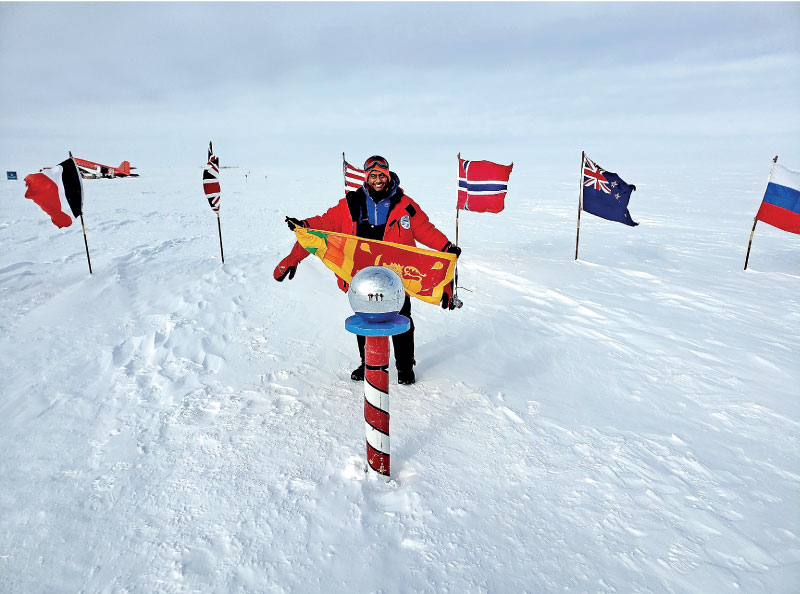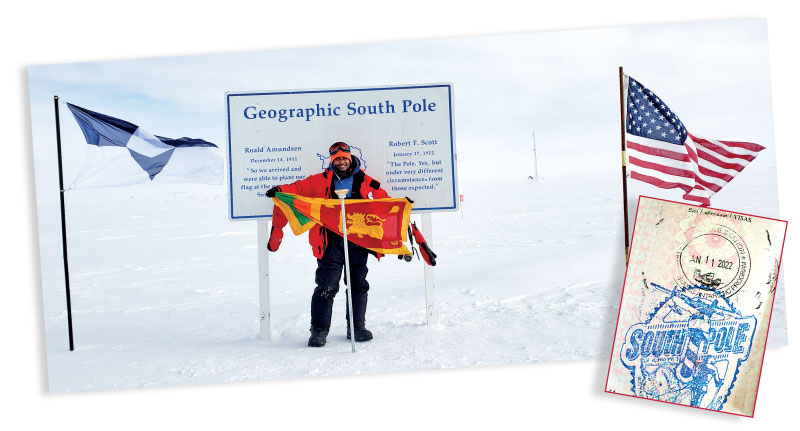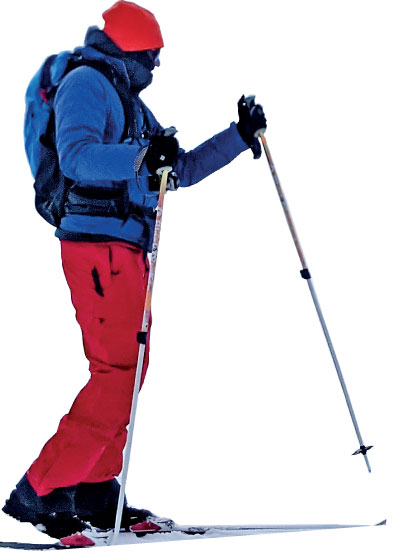Saturday Mar 15, 2025
Saturday Mar 15, 2025
Saturday, 2 April 2022 01:59 - - {{hitsCtrl.values.hits}}


Exploration of faraway places is undoubtedly an adventure. Here is Sri Lankan Dinuka Karunaratne who has recently bravely made it to the South Pole, where the Earth’s axis of rotation and the Earth’s southern hemisphere surface intersects.
The Geographic South Pole is located on the continent of Antarctica about 1,300 kilometres from the nearest open sea. Although the ground of the Geographic South Pole is slightly about 135 m above sea level, on top of it sits a thick ice plateau at an altitude of 2,835 meters above sea level. This thick ice sheet constantly moves about 10 meters per year due to its own weight. The high altitude and lack of direct sunlight makes the geographic South Pole one of the most remote places on Earth.
“Antarctica is a truly free, unbelievable landscape that you must explore,” says Dinuka. In this interview with the Daily FT, Dinuka recounts his experience
and insights.
By Medha de Alwis
 Q: Dinuka, what is your background?
Q: Dinuka, what is your background?
I have a PhD in Electrical Engineering from University of South Florida, USA. At the moment, I work for Intel Corporation as an Engineer.
Q: What made you think of the South Pole - Did you have a childhood or early adulthood idea to do this? If not, what did you think about this?
I had learned about world geography in school as a child, but I never imagined myself ever going to the Geographic South Pole or even visiting the seven continents. It was in my early adulthood I made traveling the world a priority in my life. Ever since then I used every opportunity I had, to visit a new place.
Q: Did you get any training for the success of this adventure?
When traveling to harsh environment like Antarctica or summiting any high-altitude mountain, you must be mentally and physical fit to overcome the unexpected extreme challengers. From my previous trekking trips 5,000 meters and above, I had the knowledge and experiences dealing with extremely cold temperatures, extreme wind, and extreme altitude. I trained on improving my cardio endurance and strength endurance to handle the extreme conditions.
Q: What was the preparation time?
Typically, you must plan your trip 1-2 years in advance but given the ongoing unfortunate COVID-19 pandemic, tour companies had shut down their operation for about 2 years. In mid-August 2021 I took advantage of this and planned to visit the Geographic South pole in early January.
Q: Share your knowledge on the North Pole.
The Geographic North Pole is where the Earth’s axis of rotation and the Earth’s Northern hemisphere surface intersects. Unlike the Geographic South Pole, the Geographic North Pole does not lie on any continental landmass. It lies on ice in the Arctic Ocean with geographic coordinates 90°N, the longitude is geometrically undefined and irrelevant.
The first human to reach the Geographic North Pole was the American Explorer Robert Peary on 6 April 1909. Today, during the summer months one can reach the North Pole in an icebreaker ship. The temperatures are below zero Celsius and the atmosphere is dry, and you have 24 hours of sunlight during the summer months in the Geographic North Pole. However, the weather in the Arctic is hugely variable and it’s best to prepare for the worst to enjoy your trip.
Q: Tell us why the Geographic South Pole is a significant place.
It’s not a place, it’s a point on Earth. It’s where the Earth’s axis of rotation and the Earth’s southern hemisphere surface intersects.
Q:What is the history behind the Geographic South Pole?
In 1821 Captain John Davis from the United States is believed to set foot on Antarctica for the first time. Ever since then it’s been a race to get to the geographic South Pole. In 1909 the British explorer Sir Ernest Henry Shackleton set out on an expedition to reach out to the Geographic South Pole. Unfortunately, due to safety concerns he and his team were forced to turn back 180 km from the Geographic South Pole. In 1911 a second British explorer Robert Falcon Scott set out to reach the Geographic South Pole. Unfortunately, when he and his team got there a Norwegian explorer Roald Amundsen and his team had already got to the Geographic South Pole 34 days before making the Norwegian explorer Roald Amundsen the first man to reach the Geographic South Pole on 14 December 1911.
Q: What made you visit the geographic South Pole?
Visiting the geographic south pole has always been a desire of mine. Having not been able to travel for almost two years due to the COVID-19 pandemic, and with countries opening up in mid-2021, I want to make my long due desire a reality. In August 2021 I started reaching “how to get to the Geographic South Pole in January 2022”.
Q: Tell us your experience at the Geographic South Pole and Antarctica.
It was exuberating. On 10 January I set foot on Antarctica. It was my first time on the seventh continent. That itself was an accomplishment for me. During the summer months in Antarctica the sun never goes down. I had never experienced 24 hours of sunlight before. Convincing myself to sleep was somewhat of a challenge when it was so bright. The next day the weather in the Antarctic was favourable and we were able to fly near the South Pole Visitor Center.
When we got off the plane the temperature was about -25C with blue skies, great visibility, and bearable winds. The South Pole Visitor centre is an unmanned office. It’s where I stamped my Sri Lankan passport with the South Pole Stamp. It also had information about the Geographic South Pole. From the South Pole Visitor centre, I walked towards the Ceremonial South Pole. The Ceremonial South Pole consists of a metallic sphere on a barber pole, surrounded by the flags of the original Antarctic Treaty signatory states.
This area is set aside by the Amundsen–Scott South Pole Station for photo opportunities. Next to it is the Amundsen–Scott South Pole Station. The Amundsen–Scott South Pole Station is the United States scientific research station at the South Pole of the Earth which is administered by the Office of Polar Programs of the National Science Foundation. Unfortunately, we could not visit it due to COVID-19 pandemic restrictions. From there I walked the final few hundred meters towards the Geographic South Pole. On 11 January, I was standing on the Geographic South Pole holding the Sri Lankan flag. It was such an exciting moment for me. The weather and the visibility didn’t stay in my favour for long. The temperature dropped to about -40C and it got super windy making it unsafe to stay any long time at the Geographic South Pole. In the harsh weather I had to walk about a kilometre back to the plane. When we got to the plane, the pilot informed us that the weather was too bad to fly, and we would need to seek temporary accommodation in the tents they had set up for us. After about an hour or so the weather improved, and I flew out of the South Pole towards the Union Glacier base camp in Antarctica where I would be camping for the next four days.
By the time I got back to Union Glacier base camp in Antarctica, it was facing a snowstorm and all the tents were covered in snow. I had to pile the snow away to get into my tent. After a few hours of sleep, I was ready for my next exploration in Antarctica.
About 98% of Antarctica is covered with a thick ice shield. Finding ground/soil is somewhat of a challenge and standing on ground in Antarctica was also another goal for me out of this trip. My friendly guide took me on a hike in an area called Elephant Head. It’s basically a large marble rock that was in the shape of an elephant head, hence the name. The trail takes you through rock/soil and snow. On the hike my guide surprised me by showing a fossil. This fossil was proof that Antarctica used to be part of the supercontinent and plants/animals lived on it. Returning from the hike I attended a lecture at the campsite about “The History of the expeditions in Antarctica ‘’ given by one of the camp managers.
The next day I cross-country skied to explore and experience the white desert. It was about a 10 km loop where I ski through the spectacular landscapes of Antarctica. Because the surrounding is so white there is no contrast to see the surface topography. You don’t realise you came to a snow hill until you feel the extra resistance. This wasn’t something I had experienced before and was very surprising to me.
On the final day before my departure from Antarctica I went to explore the beautiful Union Glacier and Drake Icefall. To walk on glaciers, you need to have micro spikes. Or else the ice is too slippery, and you could easily injure yourself. After safely walking onto the glacier, I got the opportunity to touch the blue crystal-clear ice with my bare hand. It was extremely cold.
Q: Did you see any wildlife in Antarctica?
I did not see any wildlife when I was in Antarctica. I was always a few hundreds of kilometres inland in the continent. You only get to see penguins, whales, seals, albatrosses and other seabirds in the coastal area of Antarctica. Those animals don’t come inland into the continent since there is no food or drinking water for them.
Q: What information can you share with fellow Sri Lankans who like to travel?
Those Sri Lankans who love to travel know the hassle of getting a visa. Fortunately, Antarctica is not owned by anyone or any country, meaning you do not need to get a visa to enter Antarctica. Saying that, travel to Antarctica typically starts from Chile (Punta Arenas), Argentina (Ushuaia), Australia (Tasmania), New Zealand (Invergordon) or South Africa (Cape Town). Sri Lankans will need to get VISA to enter any of these countries to make their way to Antarctica. One can explore Antarctica by sea, air and ground; or both. The “International Association of Antarctica Tour Operators” (www.iaato.org) has all the tour companies that operate in Antarctica. Based on your interests and capabilities you can sign up for a tour with a company. Typically, with a cruise you can explore the coastal area of Antarctica and see a lot of wildlife and the coast. With an air and ground tour you can visit the geographic south pole, summit mount Vinson (the tallest mountain in Antarctica), skydive, ski and many other activities in groups. If you are an advanced adventure traveller, you can also do a solo exploration in Antarctica. Antarctica is a truly free, unbelievable landscape that you must explore.
Q: How much did it cost? And what is the difference between the cost of visiting Antarctica and the cost of visiting the South Pole?
One can do many activities based on his or her interests and capabilities in and around the continent of Antarctica. The most common way to explore Antarctica is by a cruise from South America. These cruises sail around the Antarctic Peninsula for a few days giving the opportunity to see a lot of wildlife and experience the Drake Passage. Some cruises will off board you to take a trek and camp a night on the Antarctic Peninsula.
These types of tours cost from about $ 5,000 – 25,000 based on the level of comfort of the cruise, duration and activities. The geographic South Pole is about 1,300 km away from the nearest open sea. So, to get to the Geographic South Pole you need to fly into Antarctica with a tour company. Typically, a Geographic South Pole trip will cost in the range of $ 65,000 – 100,000. One can also summit Mount Vinson, the tallest mountain in Antarctica. This would cost about $ 50,000 – 60,000.
When visiting Antarctica, it is highly recommended to get travel, evacuation and medical insurance. To do any activity on the continent you need to be physically and mentally healthy. You also need to have experience dealing with camping gear and equipment to handle extremely cold temperatures (there are no permanent structures (hotels or cabins or bathrooms) for travellers).
Discover Kapruka, the leading online shopping platform in Sri Lanka, where you can conveniently send Gifts and Flowers to your loved ones for any event including Valentine ’s Day. Explore a wide range of popular Shopping Categories on Kapruka, including Toys, Groceries, Electronics, Birthday Cakes, Fruits, Chocolates, Flower Bouquets, Clothing, Watches, Lingerie, Gift Sets and Jewellery. Also if you’re interested in selling with Kapruka, Partner Central by Kapruka is the best solution to start with. Moreover, through Kapruka Global Shop, you can also enjoy the convenience of purchasing products from renowned platforms like Amazon and eBay and have them delivered to Sri Lanka.
Discover Kapruka, the leading online shopping platform in Sri Lanka, where you can conveniently send Gifts and Flowers to your loved ones for any event including Valentine ’s Day. Explore a wide range of popular Shopping Categories on Kapruka, including Toys, Groceries, Electronics, Birthday Cakes, Fruits, Chocolates, Flower Bouquets, Clothing, Watches, Lingerie, Gift Sets and Jewellery. Also if you’re interested in selling with Kapruka, Partner Central by Kapruka is the best solution to start with. Moreover, through Kapruka Global Shop, you can also enjoy the convenience of purchasing products from renowned platforms like Amazon and eBay and have them delivered to Sri Lanka.